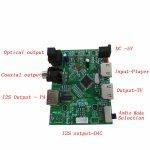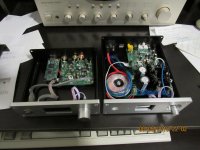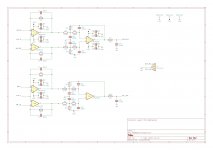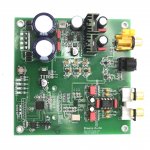why you guys don't like mems oscillators? I've got the best THD result with mems.
THD is meaningless, it matters what the exact harmonics are and the level of each one. Lets see an FFT at -25dBFS, please. Also, FFT @ 0dBFS.
Regarding mems, they have higher jitter at low offsets vs good crystal clocks, like down at 10Hz offset. If that isn't clearly audible, it just means there are bigger sound quality problems that mask it.
Maybe I will have a story before long about design optimization by measurements vs optimization by listening. For now, my lips are sealed.
Last edited:
Naaling,
Looks like the dac is bad, given both LEDs are always lit with no input present. It means a problem with the MCU, dac chip, power, or clock (those seem the most likely possibilities).
Looks like the dac is bad, given both LEDs are always lit with no input present. It means a problem with the MCU, dac chip, power, or clock (those seem the most likely possibilities).
No. It was open. I shorted the jumper when I switched to the wall wart.
If you had J6 short with +/-15 connected and on at any circumstances, then you put -15 in GND. I believe you can guess what happened next. (if no then think why they write in DS "referenced to ground")
Naaling,
Looks like the dac is bad, given both LEDs are always lit with no input present. It means a problem with the MCU, dac chip, power, or clock (those seem the most likely possibilities).
Thank you for taking the time to look at this.
I really don't have the expertise to take this any further, so it looks like the board is dead. I'll just order a replacement from ebay.
Hello! could you publish the i / v circuit once again. Do I understand correctly that there are only three operational amplifiers and are they used for both channels? and circuitry for AVCC on operational amplifiers.
Hello! could you publish the i / v circuit once again. Do I understand correctly that there are only three operational amplifiers and are they used for both channels? and circuitry for AVCC on operational amplifiers.
AVCC and Output Stage schematics can be found attached to post #3003 in this thread.
Output stage mod instructions download: Dropbox - Output Stage Instructions.zip
Schematic for the output stage mod instructions has the balanced outputs deleted, since we don't usually recommend including that part. That version of the schematic is attached below.
Attachments
Last edited:
why you guys don't like mems oscillators? I've got the best THD result with mems.
I'm surprised that the oscillators actually made any difference to distortion
measurements. Between decent oscillators the only thing I've really noticed
is the width of the 'skirt' at it's base which is effectively LF phase noise.
I believe some manufacturers use mems based oscillators in their digital
audio gear and give technical reasons for it but all of the phase noise
measurements I've seen never support this.
T
Do the stock board needs capacitors after the opamp?
If so, why?
Output caps are to remove any DC offset. The stock boards use a crude dac-voltage-mode opamp circuit that gives pretty high distortion. The DC blocking caps are the least of its problems.
Measured dc offset with several opamps. It's around 15-20mv for ths4032,ne5532 and opa2604.
I removed them,preamp already have dc blocking caps at the input.
I changed the avcc caps to 3300uf and feeding dac with salas bipolar psu.
Using ths4032. Sounds pretty good so far.
I removed them,preamp already have dc blocking caps at the input.
I changed the avcc caps to 3300uf and feeding dac with salas bipolar psu.
Using ths4032. Sounds pretty good so far.
Last edited:
Right, I've received my JLSounds USB board, I'm powering this off the 2nd secondary using my RPi 4 to provide a DSD 512 source via Roon.....impressive and so many power options available. Next is to solder a pair of LT1763 to the ground plane to provide an additional pair of 3.3v lines for the DAC and the clock and then I'm done with the hardware.....apart from the crystal.
My AK4137 has stopped working, I'm getting all the correct information displayed on the display board so it's picking up the inputs but there's no i2s output....odd!
My AK4137 has stopped working, I'm getting all the correct information displayed on the display board so it's picking up the inputs but there's no i2s output....odd!
Right, I've received my JLSounds USB board, I'm powering this off the 2nd secondary using my RPi 4 to provide a DSD 512 source via Roon.....impressive and so many power options available. Next is to solder a pair of LT1763 to the ground plane to provide an additional pair of 3.3v lines for the DAC and the clock and then I'm done with the hardware.....apart from the crystal.
My AK4137 has stopped working, I'm getting all the correct information displayed on the display board so it's picking up the inputs but there's no i2s output....odd!
Regarding DSD from I2SoverUSB, the best thing to do now would be to see how low you could set DPLL Bandwidth which could give *much* better sound quality. Requires an Arduino though.
Regarding AK4137, sure helps to have a scope when it comes to troubleshooting/fixing dacs and other devices. A DVM isn't really enough, although a few voltages on the AK4137 board could be checked which might be better than nothing.
such a board for an upgrade is better
Bought one of those boards myself to carefully examine it. It has numerous problems IMHO. Definitely not recommended.
Last edited:
Input board for SACD-DSD function

The board can use external 5V source or the HDMI power. I soldered a 5-pin header to the DAC board and connect the 2 board with 5 Arduino jumper cables. It is done. No programming, no jumper change.
I got a 3-in, 1-out HDMI switch for the Blu-Ray Sony, Firestick and Cable TV box. The DAC uses HDMI input and on DSD mode all the time. I love the DAC before and love the DSD mode even so much more. A cheap solution to good sound.
The one on the right is my DAC before mod. I will post some picture when I finish the hardware touchup.

In the past year, I added an Amazon Firestick 4K for internet/streaming input. My Sony UBP-X800 can play SACD. I have 2 DSD source and a DSD capable DAC, but no link between the HDMI only source and the DAC. My search led me to a HDMI/MHL Dual-Mode Audio Extraction I2S/DSD board on e/bay.After living with this DAC using the ES9038Q2M and toyed with the idea of updating to an ES9028PRO DAC in the last month, I decide that the sound quality of this DAC is sufficient for the TV audio, DVD and CD digital sources that I use. I built another one using dual voltage internal PSU. It requires a deeper (180mm) case. The original factory built DAC and the home built DAC is shown side by side below.
View attachment 695732
ES9028 DAC DSD Decoder Board Supports IIS DSD 384KHz Coaxial Fiber+TFT LCD | eBay
length 180mm DAC chassis Aluminium case for ES9038Q2M DAC with display window | eBay
It is the same VR1.07 SMPCE Chinese board. The new case uses the onboard RCA jacks instead of off-board ones. The new home built DAC is working fine as is, but I am waiting for the power on-off and volume knob.
The transformer is from Antek with a dual 15VAC windings. The PSU has dual full bridge rectifier with LT1083CP regulators set at +/- 15VDC.
View attachment 695733
The schematic of the PSU is notional, not the actual values of components that I used.
I like the home built DAC very, very well and may sell the factory built DAC soon. If you are interested, PM me.

The board can use external 5V source or the HDMI power. I soldered a 5-pin header to the DAC board and connect the 2 board with 5 Arduino jumper cables. It is done. No programming, no jumper change.
I got a 3-in, 1-out HDMI switch for the Blu-Ray Sony, Firestick and Cable TV box. The DAC uses HDMI input and on DSD mode all the time. I love the DAC before and love the DSD mode even so much more. A cheap solution to good sound.
The one on the right is my DAC before mod. I will post some picture when I finish the hardware touchup.

Last edited:
UBUNTU -> XU208 XMOS -> ES9038Q2M -> RCA CABLES -> AMP -> SPEAKERS
I am getting a constant 500Hz hiss on speakers. Hiss is noticeable in low volume play and
when audio is paused. But goes away computer is not playing.
In past used JBL Monitors with Balanced port, problem was not present. May be balanced
port and internal amp removing noise.
Hiss is not present when the setup is not connected to computer.
Any one else having same problem.
Thanks

I am getting a constant 500Hz hiss on speakers. Hiss is noticeable in low volume play and
when audio is paused. But goes away computer is not playing.
In past used JBL Monitors with Balanced port, problem was not present. May be balanced
port and internal amp removing noise.
Hiss is not present when the setup is not connected to computer.
Any one else having same problem.
Thanks

New thing learned is that the noise goes away when typing the keyboard (2 seconds after the last key pressed). The keyboard is connected using the bluetooth dongle in the same usb hub. I tried connecting the dac seperately but the beep is there.
I think the usb dongle is causing some changes in internal power of the usb hub causing the hiss to go away. Any input is appreciated.
I think the usb dongle is causing some changes in internal power of the usb hub causing the hiss to go away. Any input is appreciated.
New thing learned is that the noise goes away when typing the keyboard (2 seconds after the last key pressed). The keyboard is connected using the bluetooth dongle in the same usb hub. I tried connecting the dac seperately but the beep is there.
I think the usb dongle is causing some changes in internal power of the usb hub causing the hiss to go away. Any input is appreciated.
you have a simpler version of the board, there is no generator, so with not very good xmoc, noise and disruption during playback are taken
I think the usb dongle is causing some changes in internal power of the usb hub causing the hiss to go away. Any input is appreciated.
A common approach to fixing noise problems from computers is to use a galvanically isolated USB board such as I2SoverUSB. However, it needs an external +5v power supply for the isolated section that should be on the same ground as your dac, not the computer ground. In addition, if the noise is strong enough, one stage of galvanic isolation might not be enough.
Otherwise, you might try plugging the USB board into a USB port directly on the computer and or use a different power supply for the USB hub or maybe try a different hub.
Anyway, the source of the problem is in the computer so the best approach is to fix the computer or use a different one. If the problem can't be fixed at the source then trying to isolate the dac from computer power and computer ground is the next best hope.
We haven't heard from Kayata for awhile but he was getting very close to getting Arduino to work reliably. I sent him an I2C level converter, but don't know if he ever received it and or if he got it working.
Hi Mark,
I just yesterday received the sparkfun level translator you sent me. Thanks a lot. I will do the pin lifting in a few days and connect arduino and program the dac. Will post results then.
I still follow this post. Been working on the amp side with tpa3255evm biamping with active analog crossover following esp's LR filter.
Cheers,
Kay
- Home
- Source & Line
- Digital Line Level
- ES9038Q2M Board

